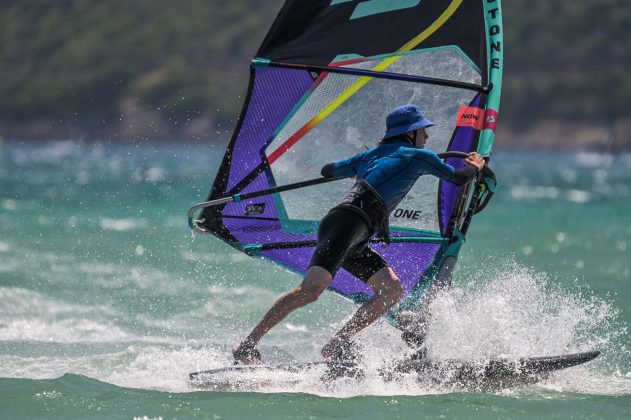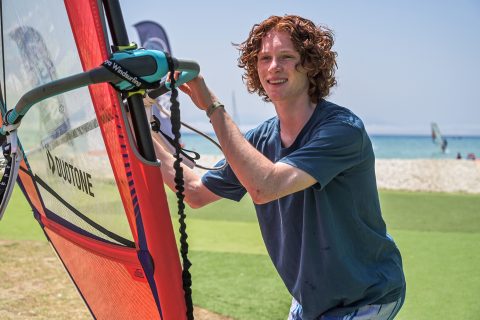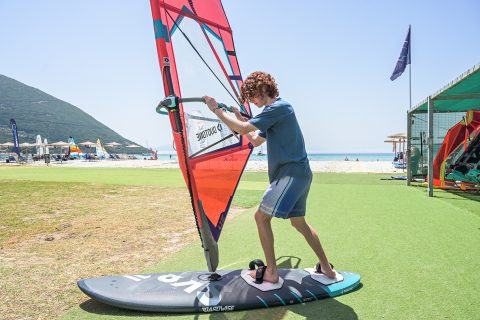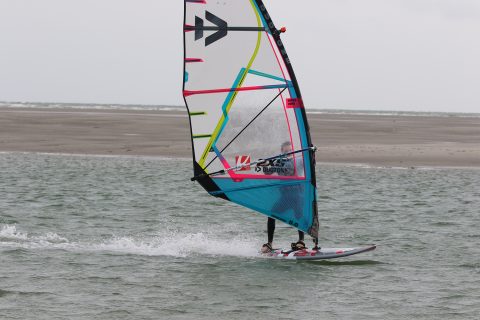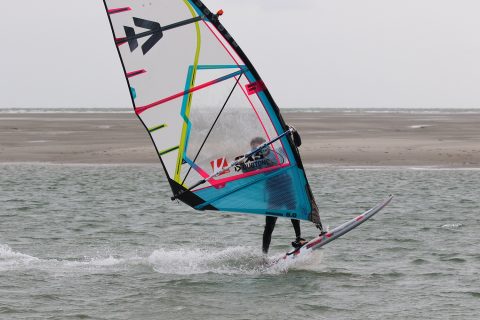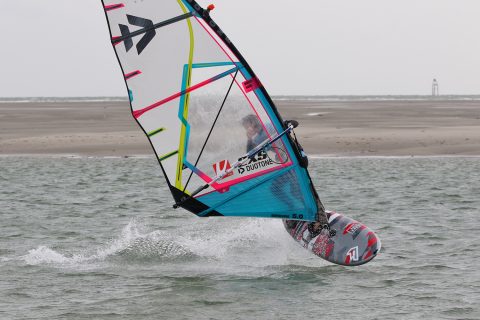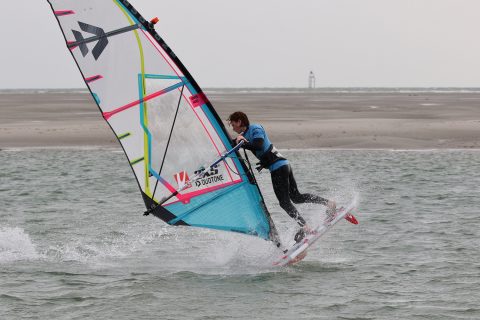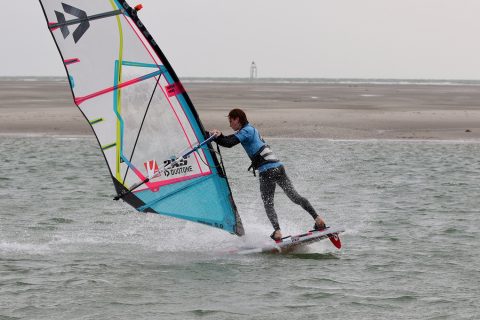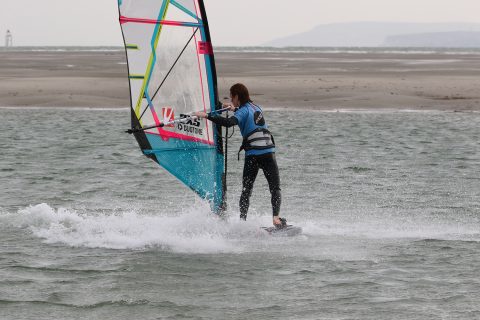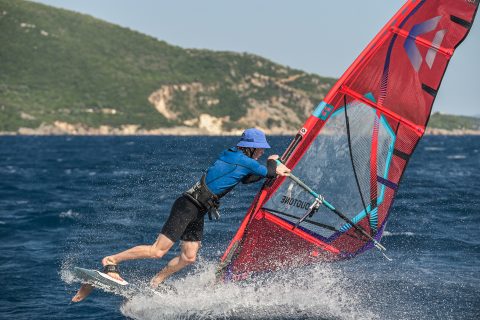FIRST FREESTYLE: HOW TO VULCAN
K66 Team rider Freddie Sargent explains how to get started with freestyle and gives a how-to guide to the Vulcan.
Words: Freddie Sargent // Photos: Simon Bassett 2XS (Vulcan sequence) and Protography Official (other).
Windsurfing is difficult enough but, ever since it was invented, people have been thinking of ways to make it harder and ‘Freestyle’ became the name given to showing off tricks. In the 70s, sailors wowed the crowds by holding the boom behind their backs, by the 80s, carving 360s and finding inventive ways of making gybes trickier, with pirouettes and other flourishes had come along, but it was the 90s, when Josh Stone invented the Vulcan and Spock, that modern freestyle began. The names of the moves became sillier, the crashes became more spectacular and freestyle moved beyond the reach of the average windsurfer. When I first saw someone do an Air Skopu, my first thoughts weren’t, I see how he did that and reckon I’ll give it a go, they were, what just happened and is he OK?
- Freddie Sargent
Having spent some time with the Club Vass instructors though, I’m beginning to see how average people can, bit-by-bit, work towards being able to do things that at first look impossible. I’m still near the beginning of the freestyle journey, but I’m loving it. Almost everyone reading this will know the feeling of getting planing for the first time, or completing your first carve gybe. The joy of freestyle is that the ‘first time’ feeling can be repeated over and over, as there are countless moves to learn.
Freestyle can seem inaccessible because it looks difficult and painful, but if you start the journey at the beginning, it starts to seem more possible.
Where to start
Whilst the ‘old school’ carving tricks (downwind 360s, push tacks etc) look cool and still impress, most people choose to start with the Vulcan as their first freestyle move, because it’s the foundation of many other tricks, and jumping tricks look more impressive! All jumping freestyle starts with a pop (getting the fin out of the water), followed by some sort of slide, spin or rotation. Once you can pop, spin and slide both downwind (Vulcan) and upwind (Flaka), then you are a freestyler and on the path. There are dozens of variations with switched feet, ducked sails etc., but they’re all based on the foundation moves of the Vulcan and Flaka.
Will a Vulcan hurt?
Yes – a bit! Before you master it, you will have to crash a lot. However, by far the scariest and most painful crash is usually the first one. If you’re not put off by the first attempt, then you’re on your way. The first crash is painful because you don’t know what to expect; your brain is on high alert and your body hasn’t yet learnt what it can take without getting injured. The most important requirement for freestyle is a willingness to absorb a few splashes, equivalent to a catapult at planing speed. And if you’re able to plane in the straps and harness on a 100-litre (or smaller) board then you’re good enough. Please don’t stop reading here – as below I’ll give some tips on how to approach the first attempt.
- Freddie Sargent pop position
Kit set-up
Freestyle boards have flat rocker lines for acceleration and speed and plenty of volume in the tail (to help popping), but wave boards can work for some freestyle, like Vulcans, as they are easy to throw around. A short fin is essential and your footstraps have to be set up so that you can twist your foot in them and eject without difficulty, as you will be doing a lot of ejecting!
The straps should be quite snug from the sides, pinching the foot a little, but reasonably generous in overall size so that, when fully jammed in, the strap should be over the middle of your foot (see photo). They should be loose enough to allow your foot to twist, but not so loose that your ankle is in the strap. As a test, it should be just loose enough to allow you to put your knee on the board with your foot still in the strap. For example, if your foot is in the back strap, then you should be able to twist your leg so that your knee ends up near the front strap. Any tighter and you risk injury to your foot, but too loose and your ankle is at risk. A single, central back footstrap is a requirement, and standard on freestyle and wave boards.
A manoeuvre-focussed sail (wave, freestyle or crossover) below 5.5m is good and you certainly don’t need a dedicated freestyle sail for Vulcans.
Vulcan how-to
1 – With as much speed as possible, sail across the wind and get into the ‘pop’ position: body weight over the board, knees bent, boom close (with bent elbows pointing down) and sheeted in to maintain mastfoot pressure and speed. Then prepare for the jump by moving your front hand right up to the boom clamp to make the sail flip easier.
2 – Pop: jump up and slightly forwards (towards the nose). Take off with the sail forwards and slightly to leeward. Allow the sail and nose of the board to rise up by sheeting out slightly.
3 – The rotation: the spin comes 90% from the sail and 10% from your body. With the sail and nose high, you sheet the sail in briefly to start the rotation, then quickly release the back hand and throw the boom (with the front hand) back in the direction you’ve come from. The rotation is both around and down. Focus on using the sail to push the nose of the board down into the water downwind of you and tucking in your back leg. This action is similar to a forward loop; the rotation changes from a forward loop into a Vulcan by releasing the back hand and throwing the sail back. At the same time, your body weight moves forwards with your head over the mastfoot. Look backwards (at your wake) to twist your upper body into the rotation, creating space to throw the sail towards the wake. Effectively, your body and the sail swap positions.
4 – As the nose catches and starts to slide, you need to keep your balance over the board by extending your back foot in the direction of travel (if the board is sliding either upwind or downwind of your body’s direction of travel then you’ll fall).
To keep the slide (and prevent the tail from digging in and stopping), you need to keep the your head over the mastfoot and actively push the sail forwards (towards the nose).
5 – Stay in this position (weight forwards) until the slide stops. With practice, you can steer the board a little by moving the sail upwind or downwind to keep the board sliding straight.
6 – Once the slide has finished, sheet in and lean against the power (forwards and upwind) to sail away before switching your feet.
Breaking it down
Like all moves (e.g. a carve gybe), there’s a lot that needs to happen at the same time, so it’s easiest to practice the parts separately. I find tips helpful when they are drip-fed, so I apologise for bombarding you here – maybe try one tip at a time before re-reading. The Club Vass team have taught so many people that they know the common mistakes and their tips are excellent; sometimes it just takes one well-targeted tip to unlock a trick. Here is a summary of their tips.
- Freddie Sargent
Popping
With your weight inboard and knees bent (see popping position below), get the feel of jumping the fin out of the water. You only need enough height to clear the fin, no more. Experiment with speed; you’ll find that the faster you’re travelling, the easier it will be to release the board from the water, but the scarier the idea of rotating will seem. When you go for your first attempt at rotating, you’ll want to be travelling just fast enough to release the fin, as it’s less scary than trying it at top speed.
Practice popping and landing flat, or slightly nose first (rather than tail first), by sheeting in after popping. Unlike a chop hop, you need to keep your body weight over the board (not outboard).

